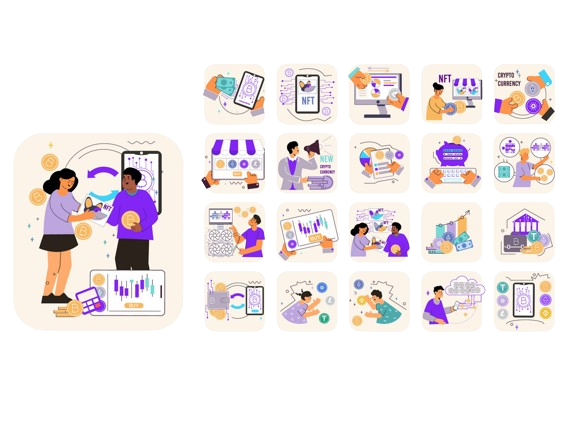
Navigating the Crytpo Labyrinth
Imagine an alternative financial system with no centralized control, manipulation, or censorship. A decentralized monetary network facilitating global, permissionless transactions. An expanding ecosystem enabling revolutionary applications that challenge conventions.
Welcome to the world of cryptocurrency and blockchain technology – a domain that can initially overwhelm yet offers immense promise. This guide serves as your Cipher to decoding the crypto matrix.
We’ll demystify essential concepts, provide context surrounding this movement, highlight leading projects, and showcase impactful applications of these technologies. Let’s embark on a journey toward comprehension, evaluating opportunities and challenges along the path to mass adoption.
Demystifying Cryptocurrency Concepts
Cryptocurrencies like Bitcoin represent internet-native digital assets secured by cryptography and recorded on blockchains – distributed ledgers spread across countless computers. They introduce groundbreaking paradigms for money, value transfer, fundraising, financial services, identity management, and governance.
Amidst the complex technical foundations, several key innovations drive cryptocurrencies’ significance:
Decentralization
Cryptocurrencies utilize consensus mechanisms like proof-of-work mining or staking to validate transactions publicly without centralized intermediaries. This eliminates single points of failure while curbing censorship.
Peer-to-Peer Networks
Payments transmit directly between participants with no financial institutions controlling flows. This enables accessible global transfer of value and financial inclusion.
Transparency
As public ledgers, blockchains record transaction histories providing accountability and transparency. However, privacy coins like Monero enable anonymous cryptocurrency transfers.
Programmability
Support for sophisticated smart contracts allows the execution of complex financial instructions and decentralized applications automatically when conditions meet.
Pseudonymity
Addresses derived from public keys instead of real-world identities afford users privacy by default. However, blockchain analysis can reveal connections.
Examining Leading Cryptocurrencies

Bitcoin initiated this domain in 2009 as a decentralized peer-to-peer electronic cash system outlined in Satoshi Nakamoto’s infamous whitepaper. Today, Bitcoin functions as a digital gold – a scarce, censorship-resistant global store of value and settlement layer for larger transactions.
Ethereum later introduced smart contracts and decentralized applications to enable an ecosystem of projects to expand functionality. Now thousands of cryptocurrencies exist, including alternative application platforms, stablecoins, privacy coins, metaverse environments, and more – each exploring design spaces.
Let’s analyze select major projects demonstrating crypto’s progression:
Bitcoin – Digital Gold
The original and most valuable cryptocurrency by market capitalization, Bitcoin set the monetary standard for the industry. Its proof-of-work mining rewards participants for validating blocks of transactions using specialized hardware and electricity.
Critics argue Bitcoin’s inefficient design can’t scale for mass adoption. Still, Bitcoin remains the undisputed cryptocurrency benchmark – appreciating enormously long-term despite volatility. For secure high-value storage and transfers, the best Bitcoin wallet options include wallets like Bitamp.
Ethereum – Smart Contracts Standard
Ethereum built upon Bitcoin’s foundation but extended functionality dramatically through smart contracts – programs enabling complex logic and decentralized applications execution using crypto-fuel called gas.
These abilities unleashed an explosion of innovative Ethereum-based decentralized finance (DeFi) platforms, non-fungible tokens (NFTs), crypto games, social networks, and more – each decentralized app (dApp) interacting seamlessly through a shared backend.
Ethereum still confronts critiques regarding congestion, complexity, carbon footprint, and other drawbacks. Upcoming upgrades like proof-of-stake consensus offer solutions by enhancing scalability, efficiency, and accessibility over time.
Polkadot – Interoperability Platform
Polkadot focuses on interoperability using a proprietary technology called Relay Chain to enable communication between disparate independent blockchain networks.
This web of interlinked chains avoids needing a “one chain serves all” approach, allowing specialized projects to bridge together seamlessly. Polkadot’s emphasis on cross-compatibility and extensibility helps overcome previous Internet innovation obstacles.
Developers leverage Polkadot’s flexibility to efficiently build for particular use cases – from DeFi to identity solutions and beyond. By transcending compatibility barriers, Polkadot expands design possibilities and seamless composability between decentralized applications.
Real-World Cryptocurrency Applications
Beyond speculative hype cycles, real-world cryptocurrency integration now expands functionality across numerous domains:
Decentralized Finance (DeFi)
DeFi apps build open-source, peer-to-peer alternatives to traditional financial services using blockchain infrastructure. From lending platforms and derivatives to stablecoins and synthetic assets, DeFi recreates the financial system with enhanced accessibility and transparency.
Non-Fungible Tokens (NFTs)
Non-fungible tokens exist on blockchains to represent digital ownership of unique assets – like artwork, music, videos, virtual real estate in metaverse environments, and more. NFTs enable digital creators to monetize work directly and gain royalties – disruptive to conventional middlemen-heavy media business models.
Supply Chain Monitoring
Blockchains introduce greater transparency for supply chain tracking from businesses like Walmart for food safety. Cryptographic verification of supply chain events – like proof of authenticity and origin, real-time order and delivery status, and other data points – mitigates fraud and errors.
Identity Management
Decentralized identity systems allow efficient, privacy-preserving management of identifying credentials – from tax documentation to medical records, passwords, and more. Users control their sensitive data sharing selectively to verify credentials without exposing unnecessary personal information.
Voting
Blockchains show early promise to enable transparent, tamper-resistant voting and reduce election fraud – from private institutions to public governmental elections. However, anonymous verifiable voting remains technically challenging to implement properly at scale.
Challenges Toward Mainstream Adoption
Progress notwithstanding, cryptocurrencies still confront obstacles on the path to widespread adoption:
Volatility
Wild price fluctuations create turbulence, undermining utility as a reliable medium of exchange and diminishing confidence among the uninitiated. Stablecoin alternatives attempt stabilization.
Complexity
These decentralized systems appear almost impossibly intricate initially. From novel terminology to advanced cryptography, the learning curve steepens mainstream assimilation. Simplification is paramount.
Regulation
Governments balance complex factors in evaluating supportive or restrictive policies – like investor protection, fraud prevention, tax evasion, capital outflows, energy usage, and anti-crime regulations. Reasonable safeguards shouldn’t ban innovation.
Unsavory Actors
Illegal usage around money laundering, malware, and the dark web tarnishes the ecosystem’s reputation despite most cryptocurrencies operating ethically and legally. Community self-regulation helps demonstrate healthy principles.
Inclusive Accessibility
Those lacking reliable internet access or requisite technological literacy struggle to participate fully. Intentional community building bridges these gaps through education and sensible simplification without forfeiting core principles.
The Future of Money and Value
Despite persisting growing pains on the path to mainstream assimilation, cryptocurrencies and blockchains demonstrate profound and disruptive potential. The promises of decentralized peer-to-peer finance speak to a daring vision – a new paradigm for money and value transfer unlike anything seen in centuries.

One day we may interact daily with borderless, international cryptocurrency marketplaces more equitable and accessible than our current system controlled by banks, governments, and institutions.
Dismissing cryptocurrencies today as merely speculative hype or tools for criminals risks forfeiting that brighter future shaped by even small positive momentum today.
The equations are complex but solvable. Solutions exist through compassion and understanding from both sides – from innovators simplifying access and governments supporting experimentation responsibly. Collaboration is key to constructing the promising foundations of the next digital economic evolution.
The choice is ours whether we collectively build this future with open minds or allow progress to languish. The potential awaits activation.